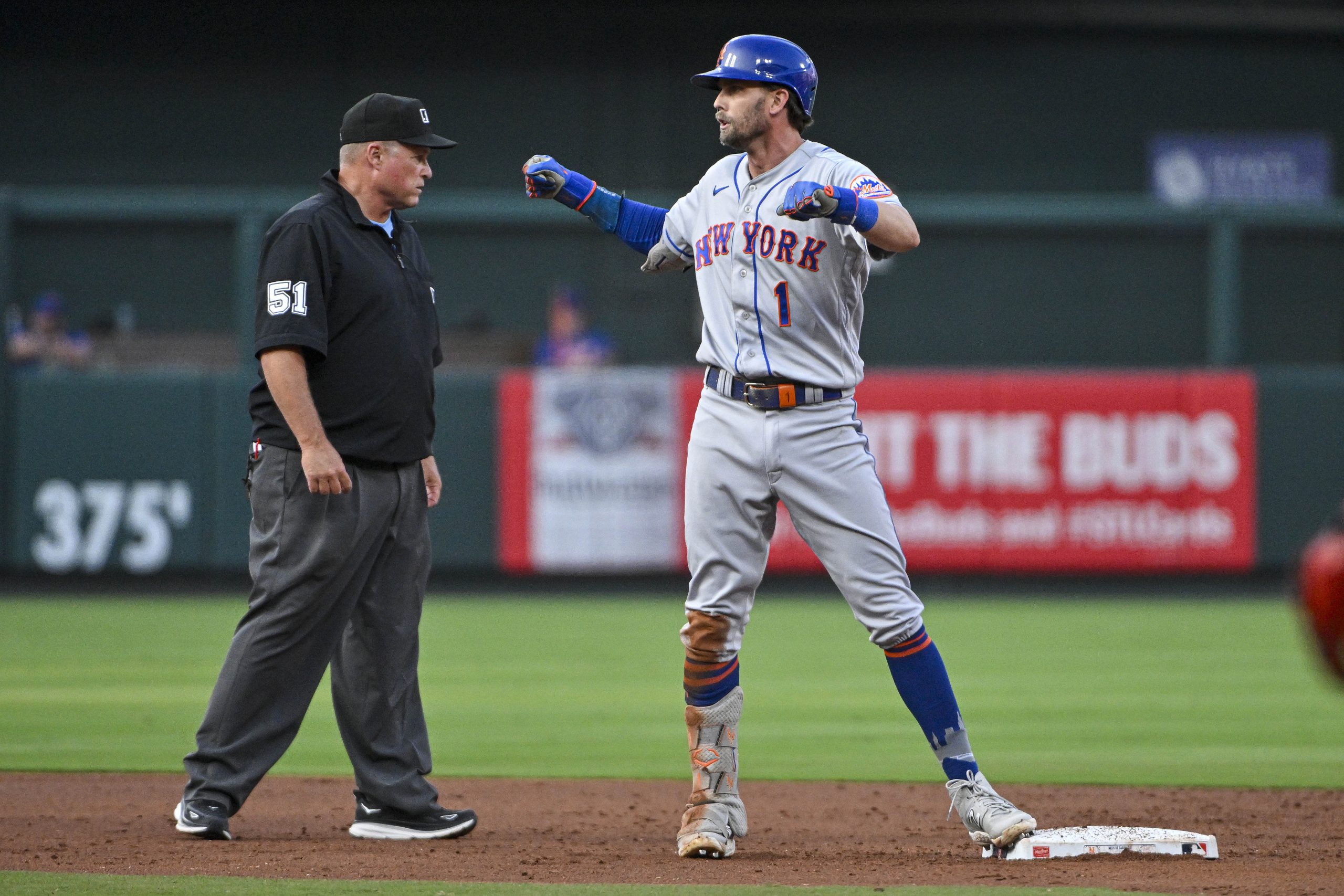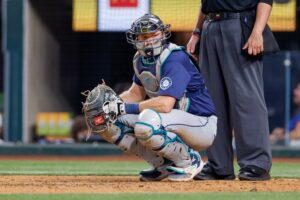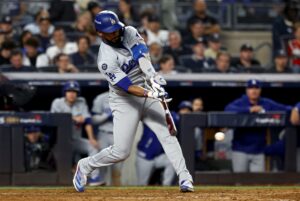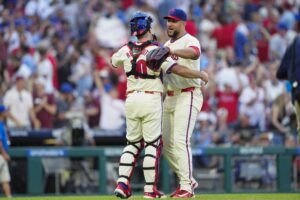The New York Mets are playing their best baseball this season, thanks to improved production from core offensive players. It helps that Brandon Nimmo, Francisco Lindor, and Pete Alonso have gone from good to great in this stretch. However, the most significant impact is that Jeff McNeil is back to performing like he should. Digging deeper into McNeil’s resurgence shows that he’s benefitting from embracing the opposite of the team’s 2023 hitting philosophy.
New Team Approach
On August 9, an article by Laura Albanese of Newsday detailed how New York’s 2023 offensive approach slightly changed from 2022 to emphasize a more selective mindset. Hitting coach Jeremy Barnes refers to the approach as “aggressive selectiveness” that ideally leads to more walks and hard contact (exit velocity over 95 mph).
“We knew that after last year, we got a lot of air quote, cheaper hits,” Barnes said in the article. “We led the league last year in infield hits for a long period of time and the two areas that we could definitely improve upon were walks and hitting the ball 95 mph. Those two things typically lead to runs. We’ve done both of those things better this year, but we just haven’t had the runs. It’s been one of those weird years.”
https://twitter.com/AlbaneseLaura/status/1689439793115983874?s=20
Entering Wednesday, the Mets’ walk percentage and isolated power have slightly, not significantly, improved since last year. The team’s strikeout rate has also increased somewhat, but not at an alarming rate. These metrics indicate the new philosophy: seeing more pitches (swinging less) leads to more walks and strikeouts, specifically of the looking variety.
The 13-point increase in ISO shows the team is hitting with more power this season. ISO measures an ability to hit for extra bases, and making the hard contact that Barnes teaches about often leads to extra-base hits. The goal is to drive the ball in the gaps or over the fence, not get bloop hits to the shallow outfield.
However, the Mets offense as a whole has regressed since last year. The team’s collective slash line in 2023 (.238/.319/.404) is worse than 2022 (.259/.332/.412). The team’s BABIP (batting average of balls in play) might represent the most significant factor in the offensive decline.
Last year’s .302 BABIP, much higher than the .259 batting average, highlights all the “lucky” and infield hits that the Mets benefitted from. These hits are soft-contact singles randomly hit where fielders couldn’t get to. But these hits have a direct impact on stats like on-base and slugging. They also allow a runner to go from first to third or second to home, which can’t happen on a walk.
The 2023 Mets, with a .273 BABIP, have not gotten these hits, seemingly by design. Thus, they haven’t reaped the benefits.
Jeff McNeil’s Approach when Struggling
McNeil historically succeeds when he puts balls in play, no matter the exit velocity. He possesses an elite bat-to-ball skill to hit the ball into open space. Even in this foul year, his Whiff percentage is in the 98th percentile, meaning he’s one of the best at making contact, even if it’s weak contact.
He excels at precisely what the Mets new hitting philosophy tries to limit. When looking at McNeil’s numbers to start the year, it’s evident that the new philosophy impacted his game.
Barnes acknowledged in the Newsday article that the team’s 2023 approach is altered to best fit the individual player. In other words, exit velocity results will be acceptable for McNeil as they will be for a player like Pete Alonso. But while the new method didn’t lead McNeil to chase exit velocity, he was more selective in his approach at the plate.
From Opening Day to June 30, McNeil hit .259 with a .334 OBP and 93 wRC+. This wRC+ indicates his offensive production was seven percent worse than the league average. During this period, McNeil swung 50.8 percent of the time and made contact with pitches out of the zone at a 74.5 percent clip.
These rates are below the 53.3 percent and 79.5 percent, respectively, clips from McNeil’s elite 2022 season. Last year, when the 31-year-old was an All-Star and batting champion, he hit .326 with a .382 OBP and 143 wRC+. Though other factors, like the shift ban, might have an impact, it’s noteworthy that McNeil’s numbers improve when he’s more aggressive.
McNeil at His Best
From July 21 through August 22, McNeil has resembled his vintage self. He is hitting .331 with a .378 OBP and 136 wRC+. Unsurprisingly, McNeil has swung the bat and made more contact during this period. His swing percentage in this streak is almost 5 percent higher than it was from Opening Day to June 30. Additionally, his connection with pitches he’s swung at that are out of the strike zone increased by 9.9 percent in this period.
McNeil seemingly went back to focusing on putting the ball in play. His BABIP in this hot stretch is .336, much higher (.285) than during his struggle period but slightly lower (.353) than in 2022. His aggressiveness has led to four games in August with three or more hits. That’s the most of such games in any month this year.
Jeff McNeil, games with 3+ hits:
🔹 April: 3
🔹 May: 2
🔹 June: 0
🔹 July: 1
🔹 August: 4He is hitting .329 in August pic.twitter.com/gmeyXjPvYv
— SNY Mets (@SNY_Mets) August 22, 2023
Is McNeil Back, or Just Getting Lucky?
When analyzing a player with a .336 BABIP, a likely conclusion is that the streak is unsustainable. Luck runs out, and a regression to the norm is inevitable. However, McNeil has multiple years of elite production in this style. There’s logic in concluding that McNeil is back to his usual self and isn’t just having a hot streak.
It will be interesting to see if McNeil can ride this success through the end of the season. But for now, being aggressive, the antithesis of Barnes’ approach, fuels McNeil’s game. Working counts and seeing more pitches is often a sound strategy. Increasing pressure on the pitcher can lead him to more pitches out of the zone (leading to more walks) or pitches over the heart of the plate. These are the pitches that are usually hit hard for damage.
This strategy typically resonates with players with plus power. Being selective means focusing on pitches they can drive for extra-base hits rather than pitches that will likely result in weak contact.
This is not McNeil.
He thrives at being a pesky hitter who can be aggressive but not a free swinger. He doesn’t need to take pitches at the strike zone’s edges in search of one in the plane of his bat path. McNeil doesn’t need to search for “his pitch” since he can take bad pitches and adjust his swing to poke the ball into the open field. By putting the ball in play and spraying it around the area, he successfully puts pressure on defenses.
Make that a 7-game hitting streak for Jeff McNeil! pic.twitter.com/zS1202qvYC
— SNY (@SNYtv) August 22, 2023
Impact on the Lineup
Frustrated Mets fans have written McNeil off. Usually a fan favorite, McNeil has become a figure that many fans don’t see as part of the core due to his struggles.
Stop telling me Jeff McNeil is okay. He’s useless in the lineup. If he doesn’t hit .300+, what does he bring to the table?
He has no power, no speed, he’s not defensively savvy. Pull him from the lineup. #LGM pic.twitter.com/SMDoK5iEY8
— James Nolan (@James1Nolan) July 21, 2023
Fans’ frustration is valid. If McNeil doesn’t hit for average, what does he bring to the table offensively? The Mets have many top prospects able to play their positions. There might be better value elsewhere if McNeil doesn’t hit.
However, his recent stretch should remind everyone of McNeil’s significant impact on this lineup. The Mets can find a player for cheap who can walk and hit the ball hard (hello Tommy Pham). A player that can consistently hit for average is harder to find and, thus, more expensive. The Marlins had to trade a good, established pitcher and a top prospect for this type of player (Luis Arraez).
McNeil brings a unique element that benefits any lineup. Hism to correlate to when he changes his hitting philosophy. McNeil said he struggled in 2021 because he wanted to hit more homers and thrived in 2022 by returning to his old ways. This season, he worked when he changed his ways to become more selective.
His recent success should remind everyone how important he is for this lineup. Selling low on McNeil would be a mistake, especially if the Mets want to be competitive next year. He will excel more consistently if he stops tinkering with his approach at the plate.
McNeil learned once that he’s best when he focuses on being aggressive and putting the ball in play. It’s a shame he had to learn that lesson once again. It’s an enormous shame that the Mets signed him to an extension to try to change him as a hitter.
Main Photo Credits: Jeff Curry-USA TODAY Sports






